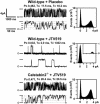Enhancing calstabin binding to ryanodine receptors improves cardiac and skeletal muscle function in heart failure
- PMID: 15972811
- PMCID: PMC1172237
- DOI: 10.1073/pnas.0500353102
Enhancing calstabin binding to ryanodine receptors improves cardiac and skeletal muscle function in heart failure
Abstract
Abnormalities in intracellular calcium release and reuptake are responsible for decreased contractility in heart failure (HF). We have previously shown that cardiac ryanodine receptors (RyRs) are protein kinase A-hyperphosphorylated and depleted of the regulatory subunit calstabin-2 in HF. Moreover, similar alterations in skeletal muscle RyR have been linked to increased fatigability in HF. To determine whether restoration of calstabin binding to RyR may ameliorate cardiac and skeletal muscle dysfunction in HF, we treated WT and calstabin-2-/- mice subjected to myocardial infarction (MI) with JTV519. JTV519, a 1,4-benzothiazepine, is a member of a class of drugs known as calcium channel stabilizers, previously shown to increase calstabin binding to RyR. Echocardiography at 21 days after MI demonstrated a significant increase in ejection fraction in WT mice treated with JTV519 (45.8 +/- 5.1%) compared with placebo (31.1 +/- 3.1%; P < 0.05). Coimmunoprecipitation experiments revealed increased amounts of calstabin-2 bound to the RyR2 channel in JTV519-treated WT mice. However, JTV519 did not show any of these beneficial effects in calstabin-2-/- mice with MI. Additionally, JTV519 improved skeletal muscle fatigue in WT and calstabin-2-/- mice with HF by increasing the binding of calstabin-1 to RyR1. The observation that treatment with JTV519 improved cardiac function in WT but not calstabin-2-/- mice indicates that calstabin-2 binding to RyR2 is required for the beneficial effects in failing hearts. We conclude that JTV519 may provide a specific way to treat the cardiac and skeletal muscle myopathy in HF by increasing calstabin binding to RyR.
Figures





Similar articles
-
FKBP12.6-mediated stabilization of calcium-release channel (ryanodine receptor) as a novel therapeutic strategy against heart failure.Circulation. 2003 Jan 28;107(3):477-84. doi: 10.1161/01.cir.0000044917.74408.be. Circulation. 2003. PMID: 12551874
-
A new cardioprotective agent, JTV519, improves defective channel gating of ryanodine receptor in heart failure.Am J Physiol Heart Circ Physiol. 2003 Mar;284(3):H1035-42. doi: 10.1152/ajpheart.00722.2002. Epub 2002 Nov 14. Am J Physiol Heart Circ Physiol. 2003. PMID: 12433661
-
JTV519 (K201) reduces sarcoplasmic reticulum Ca²⁺ leak and improves diastolic function in vitro in murine and human non-failing myocardium.Br J Pharmacol. 2012 Oct;167(3):493-504. doi: 10.1111/j.1476-5381.2012.01995.x. Br J Pharmacol. 2012. PMID: 22509897 Free PMC article.
-
Novel therapy for heart failure and exercise-induced ventricular tachycardia based on 'fixing' the leak in ryanodine receptors.Novartis Found Symp. 2006;274:132-47; discussion 147-55, 272-6. Novartis Found Symp. 2006. PMID: 17019810 Review.
-
Immunophilins and coupled gating of ryanodine receptors.Curr Top Med Chem. 2003;3(12):1383-91. doi: 10.2174/1568026033451907. Curr Top Med Chem. 2003. PMID: 12871170 Review.
Cited by
-
Calcium cycling proteins and heart failure: mechanisms and therapeutics.J Clin Invest. 2013 Jan;123(1):46-52. doi: 10.1172/JCI62834. Epub 2013 Jan 2. J Clin Invest. 2013. PMID: 23281409 Free PMC article. Review.
-
Effects of K-201 on the calcium pump and calcium release channel of rat skeletal muscle.Pflugers Arch. 2008 Oct;457(1):171-83. doi: 10.1007/s00424-008-0504-7. Epub 2008 May 6. Pflugers Arch. 2008. PMID: 18458945
-
Crystal structure and conformational flexibility of the unligated FK506-binding protein FKBP12.6.Acta Crystallogr D Biol Crystallogr. 2014 Mar;70(Pt 3):636-46. doi: 10.1107/S1399004713032112. Epub 2014 Feb 15. Acta Crystallogr D Biol Crystallogr. 2014. PMID: 24598733 Free PMC article.
-
Review of RyR1 pathway and associated pathomechanisms.Acta Neuropathol Commun. 2016 Nov 17;4(1):121. doi: 10.1186/s40478-016-0392-6. Acta Neuropathol Commun. 2016. PMID: 27855725 Free PMC article. Review.
-
Intracellular calcium leak in heart failure and atrial fibrillation: a unifying mechanism and therapeutic target.Nat Rev Cardiol. 2020 Nov;17(11):732-747. doi: 10.1038/s41569-020-0394-8. Epub 2020 Jun 18. Nat Rev Cardiol. 2020. PMID: 32555383 Free PMC article. Review.
References
-
- Hunt, S. A., Baker, D. W., Chin, M. H., Cinquegrani, M. P., Feldman, A. M., Francis, G. S., Ganiats, T. G., Goldstein, S., Gregoratos, G., Jessup, M. L., et al. (2001) J. Am. Coll. Cardiol. 38, 2101-2113. - PubMed
-
- Kramer, R. S., Mason, D. T. & Braunwald, E. (1968) Circulation 38, 629-634. - PubMed
-
- Harrington, D. & Coats, A. J. (1997) Curr. Opin. Cardiol. 12, 224-232. - PubMed
-
- Bers, D. M., Eisner, D. A. & Valdivia, H. H. (2003) Circ. Res. 93, 487-490. - PubMed
Publication types
MeSH terms
Substances
LinkOut - more resources
Full Text Sources
Other Literature Sources
Medical
Research Materials
Miscellaneous

